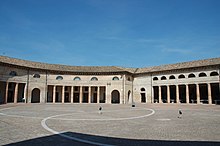Senigallia
From Wikipedia, the free encyclopedia
| Comune di Senigallia | |
|---|---|
 Municipal coat of arms | |
| Country | |
| Region | Marche |
| Province | Ancona (AN) |
| Mayor | Luana Angeloni |
| Elevation | 3 m |
| Area | 115 km² |
| Population | |
| - Total (as of December 31, 2004) | 43,899 |
| - Density | 359/km² |
| Time zone | CET, UTC+1 |
| Coordinates | |
| Gentilic | Senigalliesi |
| Dialing code | 071 |
| Postal code | 60019 |
| Frazioni | Marzocca, Montignano, Cesano, Vallone, Bettolelle, Borgo Passera, S.Angelo, San Silvestro, Scapezzano, Roncitelli, Vasari, Mandriola, Gabriella, Castellaro, Cannella, Brugnetto , Borgo Catena |
| Patron | St. Paulinus |
| - Day | May 4 |
| | |
| Website: www.comune.senigallia.an.it | |
Senigallia or Sinigaglia is a comune and port town on Italy's Adriatic coast, 25 km by rail north of Ancona, in the Marche region, province of Ancona. The small port is formed by the lower reaches of the Misa, a stream which flows through the town between embankments constructed of Istrian marble.
Contents[hide] |
[edit] History
Senigallia, spread out along the coast at the mouth of the river Misa, was founded in the 4th century B.C. by the Gallic tribe of the Senones and was the first Roman colony on the Adriatic shore. A colony was founded there by the Romans after their victory over the tribe of the Senones, rather before 280 BCE: the name is probably a later Roman corruption of Senones; the addition Gallica distinguishes it from Saena (Siena) in Etruria. The place is also mentioned in connection with Hasdrubal's defeat at the Metaurus in 207 BCE. It was destroyed by Pompey in 82 BCE, and is not often mentioned afterwards.
Ravaged by Alaric, Senigallia was fortified by the Byzantines, and again laid waste by the Lombards in the 8th century and by the Saracens in the 9th.
It was the second easternmost of the five cities of the medieval Adriatic duchy of Pentapolis, east of Fano and west of Ancona.
Senigallia used to hold one of the largest fairs in Italy, which dated originally from 1200, when Sergius, count of Senigallia, received from the count of Marseilles, to whose daughter he was affianced, certain relics of Mary Magdalene; this fair used to be visited by merchants from France, Switzerland, Austria, Germany and especially the Levant.
Senigallia was at length brought so low by the Guelph and Ghibelline wars, and especially by the severities of Guido I da Montefeltro, that it was chosen by Dante as the typical instance of a ruined city. In the 15th century it was captured and recaptured again and again by the Malatesta and their opponents. Sigismondo Pandolfo Malatesta of Rimini erected strong fortifications round the town in 1450-1455. The lordship of Senigallia was bestowed by Pius II on his nephew Antonio Piccolomini, but the people of the town in 1464 placed themselves anew under Pope Paul II, and Giacomo Piccolomini in 1472 failed in his attempt to seize the place. Sixtus IV assigned the lordship to the Della Rovere family, from whom it was transferred to Lorenzo de Medici in 1516. After 1624 it formed part of the Papal State's legation (province) of Urbino.
[edit] Main sights
Despite its ancient origin the city presents a modern appearance, with wide streets. Attractions include:
- Palazzo Comunale, from the 17th century.
- The Castle (Rocca Roveresca), of Gothic origin, was restored by Baccio Pontelli in 1492.
- The Cathedral, erected after 1787.
- The church of Santa Maria delle Grazie, outside the town, is one of the only two churches which he is known to have executed (the other is at Orciano near Mondavio, about 20 km to the west by road).
[edit] Celebrities
- Giovanni Maria cardinal Mastai-Ferretti, who became Pope Pius IX
- Gaetano Bedini (15 May 1806 - 6 September 1864) Cardinal and diplomat of the Catholic Church.
- Mario Giacomelli (1925 2000) Photographer.
- Ferruccio Ferroni (1920 - living) Photographer.
- Fabri Fibra (1976) Italian rapper.
[edit] Twinned cities
[edit] Sources and references
- "Sinigaglia" — article on the Catholic diocese, from the New Advent Catholic Encyclopædia
- This article incorporates text from the Encyclopædia Britannica Eleventh Edition, a publication now in the public domain.
| This Marche location article is a stub. You can help Wikipedia by expanding it. |








No comments:
Post a Comment